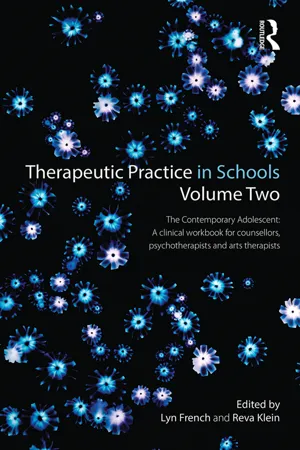
Therapeutic Practice in Schools Volume Two The Contemporary Adolescent
The Contemporary Adolescent:A Clinical Workbook for counsellors, psychotherapists and arts therapists
- 206 pages
- English
- ePUB (mobile friendly)
- Available on iOS & Android
Therapeutic Practice in Schools Volume Two The Contemporary Adolescent
The Contemporary Adolescent:A Clinical Workbook for counsellors, psychotherapists and arts therapists
About This Book
In common with Therapeutic Practice in Schools: Working with the Child Within (Routledge 2012), this second volume serves as a practical handbook for school-based counsellors, psychotherapists, arts therapists and play therapists working with young people. Written in accessible language, it is eminently applicable to the practice of both qualified and trainee therapists.
Therapeutic Practice in Schools: The Contemporary Adolescent begins with an overview of key psychoanalytic ideas informing our understanding of adolescence before moving on to focus on life circumstances and issues which commonly bring young people to the therapist's consulting room in the school. Dedicated chapters on key themes including identity, relationships, sex and sexuality, anger issues, self-harm, bereavement and bullying aim to deepen our understanding of the adolescent experience while also providing the therapist with invaluable insights into what one might say in the 'here and now' of the session. Chapter authors, all with considerable experience in the field, discuss approaches to sustaining the therapeutic relationship in the face of ambivalence or defiant resistance as well as thinking about the impact of social media on all aspects of adolescent development. The advantages and limitations of working with adolescents in the educational setting where school staff will have their own reasons for referring students for therapy, while the young people themselves might come with a very different agenda, are also covered.
It is widely acknowledged that engaging troubled or troublesome adolescents in therapy can make an enormous difference to their lives. This book ensures that both trainee and qualified therapists are supported in the often daunting yet ever stimulating and enlivening task of working with young people in the school setting.
Frequently asked questions
Information
Table of contents
- Cover
- Title
- Copyright
- Contents
- List of contributors
- Foreword
- Acknowledgements
- Introduction
- PART I The context
- PART II Common themes
- PART III Using creative approaches and applied therapies
- Index